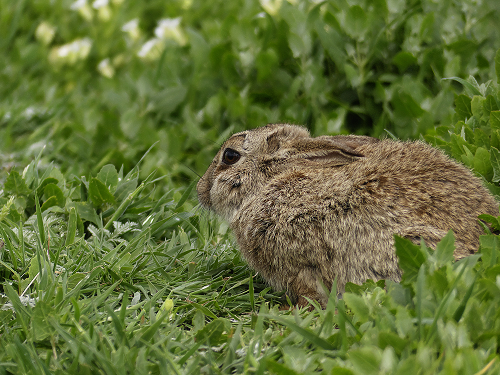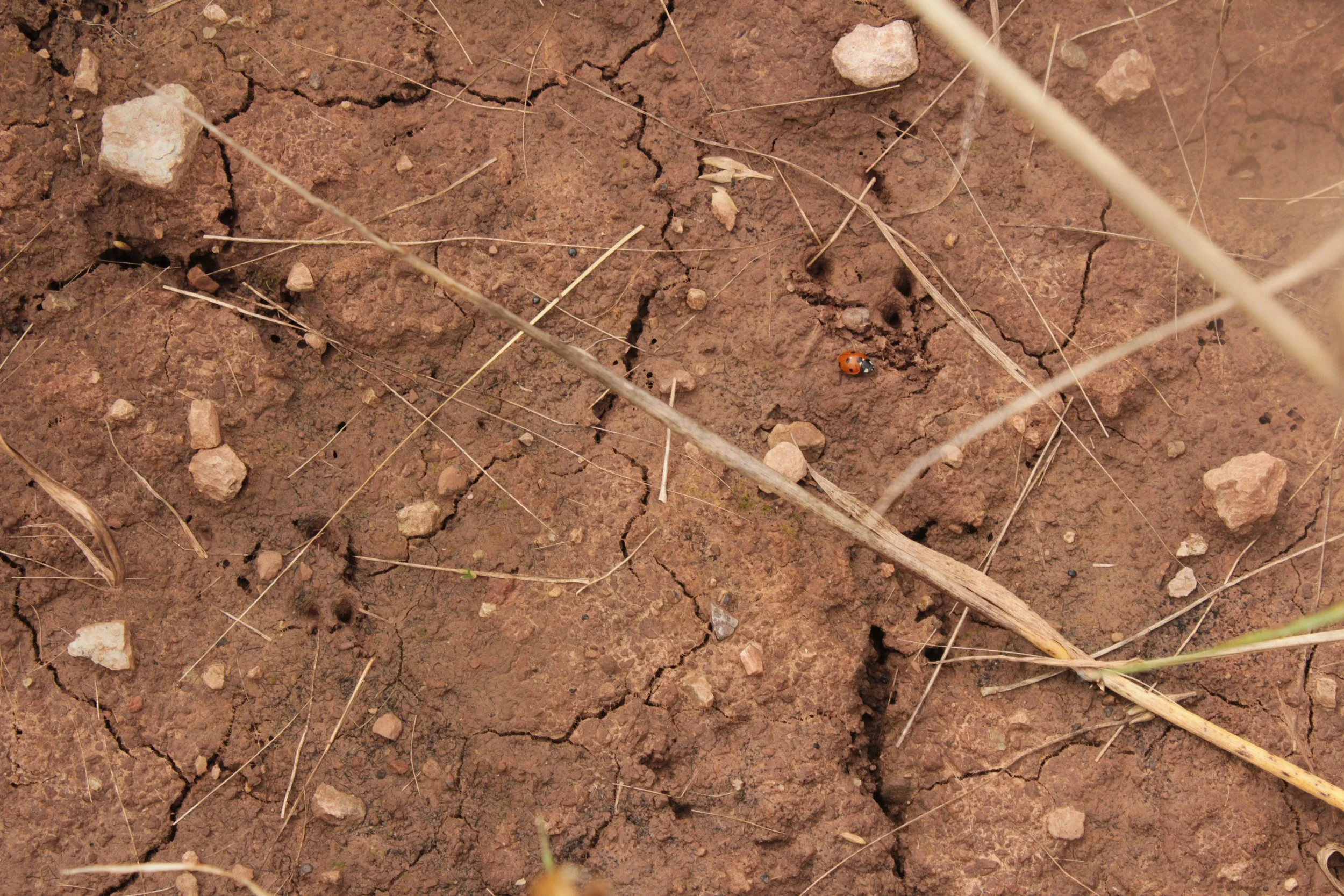Home / British mammals / European rabbit
European rabbit
Scientific name: Oryctolagus cuniculus
“Rabbit underground, rabbit safe and sound.”
― Richard Adams, Watership Down
Able to have up to around 25 young a year, European rabbits are prolific breeders and ecosystem engineers due to their burrowing and grazing, though they suffer heavily from rabbit haemorrhagic disease (RHD) and myxomatosis virus.
Taxonomy chart
Animalia - Chordata - Mammalia - Lagomorpha - Leporidae - Oryctolagus - O. cuniculus
Conservation status: UK Red List
GB: N/A
England: N/A
Scotland: N/A
Wales: N/A
Global: Near Threatened
Species information
Status: Non-native
Diet: Grasses, cereal crops, root vegetables, shoots, tree bark.
Habitat: Urban and gardens, deciduous woodland, grassland, mixed woodland, arable land.
Size: >40cm. Weight: 1.2-2kg, males heavier than females.
Lifecycle: Breeding January-August, 1 litter of 3-7 young per month, which are weaned at 21-25 days. Lifespan of maximum 3 years.
Conservation concerns: Outbreaks of rabbit haemorrhagic disease (RHD) and the virus myxomatosis are the main threat to rabbit populations in the UK.
Terminology
Doe: An adult female rabbit.
Buck: An adult male rabbit.
Kit: A young rabbit.
Warren: A series of interconnected underground tunnels, dens, and bolt holes in which rabbits live.
Geography
Rabbits are widespread throughout Britain and Ireland, but are absent from Rum, the Isles of Scilly and a few smaller islands.
Rabbits can be found almost anywhere they can burrow, such as in sand dunes, railway verges and even in urban areas. The most suitable areas are those where the burrow area and food supply are side-by-side, such as along woodland edges and hedgerows. Open warrens are maintained where good burrowing conditions exist on areas of short grass, sand dunes, railway verges and in urban areas. They are rarely found above the tree line and avoid damp conditions and areas deep in conifer woodland.
Biology
Rabbits are usually up to 40cm in height, with a weight of 1.2-2kg, though males tend to be larger than females.
Rabbits have long ears without black tips and long hind legs; their colouring is sandy, and they have a bobbing stride.
Their breeding season is mainly from January to August, and they produce several litters a year – sometimes more than 5 – of 3-7 young per month. The doe constructs a nest inside a burrow from grass bedding and lines it with soft fur from her chest and belly, with her gestation period usually being around 30-31 days. The young kittens are born blind, deaf and almost hairless. Their eyes open at 10 days, after which they begin to appear at the burrow entrance at 18 days and are weaned at 21-25 days. Bucks are able to mate at 4 months and does at 3.5 months.
Ecology
Rabbits are herbivores and will eat a wide range of plants including grasses, cereal crops, root vegetables and young shoots of meadow plants, as well as tree bark, especially when snow covers other food sources. Young rabbits are preyed on by badgers, buzzards and weasels, whilst rabbits of all ages are eaten by foxes, cats, stoats and polecats.
The network of tunnels, dens and bolt holes that rabbits occupy is known as a warren. The depth of the burrows in the warren depends on the nature of the soil and the height of the water table, and large warrens usually have a high population of rabbits – social groups varying from a single pair all the way up to 30 rabbits using the same warren!
Rabbits are normally nocturnal but will sometimes come out in daylight, especially during summer. Within large groups of rabbits, there is a distinct social hierarchy; the most dominant bucks (breeding males) have priority of access to the does (breeding females), and the most dominant does have access to the best nest sites. Bucks and does rarely fight with each other, but fights between does for nest sites can lead to serious injuries and death. In groups with more than one female and more than one male, rabbits are non-monogamous. Lower ranking rabbits may be forced to breed in single entrance breeding ‘stops’ away from the main burrows, where they and their young are more vulnerable to predators.
Some organisations define rabbits as a keystone species, despite them being non-native to the UK, as they fill an important ecological niche. Rabbits will disturb the ground through grazing, pawscraping, and burrowing, and are also highly selective grazers, creating mosaics of different vegetation which can benefit lowland grassland, heath, and dune habitats, where rabbits can maintain favourable conditions for mosses, lichens, and other species communities. Rabbit warrens are also used as shelter and refuge by various other species – small mammals, invertebrates, and even reptiles and amphibians, supporting wider biodiversity.
Conservation
Rabbits have no legal protection in Britain, and landowners are allowed to control their numbers according to their own management priorities.
In the middle of the 19th century, rabbits were widely considered to be agricultural pests, because they caused damage to crops and competed with livestock for pasture, but the spread of the virus myxomatosis in the 1950s killed off the majority of them. Now, they are slowly developing resistance, but the virus is still fatal. Myxomatosis is spread by mosquitoes, fleas, flies, and mites, and causes swelling in rabbits, as well as high fever and extreme tiredness. Other haemorrhagic viruses have been introduced and can prove fatal for rabbits, such as RHDV1 and RHDV2, which were discovered in the 90s’ and 2010s’. RHD has now become a key issue for rabbits, as it has such a high fatality rate, attacking the rabbits’ organs, such as the liver, and causing internal bleeding, as well as lethargy and lack of appetite.
History
Rabbits were brought to the British Isles in the 1st century by the Romans, when they were kept as livestock for food. However, it is most likely the Normans in the 12th century who were responsible for rabbits becoming established in Britain. There is also evidence of rabbits being present in Britain before the last ice age, so they may have been part of our ecology in the past and then killed off in the ice age and absent until reintroduced. In the middle of the 19th century, rabbit numbers increased dramatically, becoming major agricultural pests. Their increase was due to the large-scale planting of hedgerows, which provided shelter and burrows in the for them in the loosened soil. New agricultural technology increased cereal production, which also increased their food supply, and large numbers of the rabbits’ natural predators were killed by gamekeepers on new shooting estates. By 1950, rabbits destroyed approximately £50 million worth of crops per year, but the virus myxomatosis appeared, and within 2 years, 99% of the population had died. Rabbits are now developing resistance, though outbreaks still occur.
Across European and British folklore (as well as even further abroad), rabbits and hares were often associated with femininity and magic and were seen as symbols of fertility and the lunar cycle.
In Ancient Greece, the goddess Aphrodite was associated with rabbits, who were said to have the ‘gift of fertility’. In Ancient Rome, rabbits were given to women who were barren but trying to conceive. Ancient Celtic tribes deemed rabbits as taboo food – they instead used rabbits for divination and other magical practices, believing that rabbits created burrows underground to better communicate with the spirit world and could thus carry messages from the world of the living to the world of the dead.
But when Christianity started to establish a foothold across Europe and Britain, rabbits and hares – who used to be associated with women, the moon, and magical practices – were often designated as witches’ familiars, and demonic ‘rabbits’ can still be found in cathedral carvings, though white rabbits also symbolised Christian purity and piety.
In more modern times, rabbits feature in cultural works such as Beatrix Potter’s famous fictional character ‘Peter Rabbit’, Watership Down, and the white rabbit in Alice in Wonderland, as well as in expressions such as ‘breeding like rabbits’, once again a nod to their link with fertility.
How to identify
Footprints: Tracks can be seen in mud and sand, but are often easiest to identify in snow. Rabbit footprints are similar to those of the hare, but smaller in size. They have four pads on both their fore and hind feet, and their hind feet often leave an elongated, slipper-shaped impression with a width of 2.5cm and length of 3.5cm.
Droppings: Rabbit droppings are often found in grassland habitats, field edges and hedgerows. They may be found in dense collections of pellets on prominent features such as anthills. They are 10mm in diameter, yellowish brown-green, and smell sweet, like a damp digestive biscuit with a hint of mown hay.
Recommended reading
Shifting-Sands-Techniques-to-encourage-European-rabbit-recovery.pd
Frequently asked questions
-
No, rabbits are usually non-monogamous; they mate with multiple different partners.
-
Yes, in the UK, domestic rabbits can interbreed with domestic rabbits, as domestic rabbits descend from European rabbits.
-
No, rabbits do not hibernate, but they survive winter by becoming less active and staying much of the time in deep insulated burrows, huddling together for warmth. They also grow a thicker winter coat and seek energy rich foods, such as pine needles.
-
Although European rabbits can digest carrots, this would not be one of their main food sources in the wild; they usually eat grasses, cereals, and other vegetation.
-
European rabbits are classified as non-native, as they were imported to the UK by Romans in the 1st century, though it was likely the Normans who were responsible for their establishment in the 12th century.
Confusion species
Brown hare (Lepus europaeus)
Brown hares have amber eyes, compared to the brown eyes found in rabbits. Brown hares are also larger than rabbits, with longer limbs, and ears that are twice the length of their head with distinctive black tips. They have orange/brown fur on their flanks, compared to the grey/brown fur of rabbits.
Mountain hare (Lepus timidus)
Mountain hares are larger than rabbits, with longer limbs and longer ears with distinctive black tops. They have pale grey bodies in the summer, which can turn white in the winter, whereas rabbits have grey/brown fur all year round.
Identify sounds
Heard a curious animal sound but no idea whose making it?
Wildlife identification FAQ
Still not sure what you’ve found? Head over to our FAQ for an answer.







